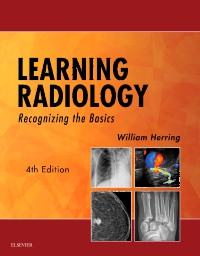
Learning Radiology Elsevier eBook on VitalSource, 4th Edition
Elsevier eBook on VitalSource

Now $42.77
The leading introductory radiology text for medical students and others who are required to read and interpret common radiologic images, Learning Radiology, 4th Edition, stresses an easy-to-follow pattern recognition approach that teaches how to differentiate normal and abnormal images. Dr. William Herring’s clear, conversational writing style employs a touch of humor to explain what you need to know to effectively interpret medical images of all modalities. From the basics of patient safety, dose reduction, and radiation protection to the latest information on ultrasound, MRI, and CT, this concise, user-friendly text provides a complete, up-to-date introduction to radiology needed by today’s students.
Newer Edition Available
-
- Teaches how to arrive at a diagnosis by following a pattern recognition approach, and logically overcome difficult diagnostic challenges with the aid of decision trees.
- Features an easy-to-read bulleted format, high-quality illustrations, useful tables, and teaching boxes, as well as special content on Diagnostic Ptifalls; Really Important Points; Weblinks; and Take-Home Points.
- Includes three new chapters: Vascular, Pediatric, and Point-of-Care Ultrasound; Using Image-Guided Interventions in Diagnosis and Treatment (Interventional Radiology); Recognizing the Imaging Findings of Breast Disease.
- Helps ensure mastery of the material with additional online content, bonus images, and USMLE-style Q&A that provide effective chapter review and quick practice for your exams.
- Shares the extensive knowledge and experience of esteemed author Dr. William Herring―a skilled radiology teacher and the host of his own specialty website, www.learningradiology.com.
- Offers quick review and instruction for medical students, residents, and fellows, as well as those in related fields such as nurse practitioners and physician assistants.
- Includes an Enhanced eBook version with purchase. Your enhanced eBook allows you to access all of the text, figures, and references from the book on a variety of devices.
-
1 Recognizing Anything: An Introduction to Imaging Modalities
Many Shades of Gray
Conventional Radiography (Plain Films)
The Five Basic Densities
Computed Tomography
Ultrasound
Magnetic Resonance Imaging
Fluoroscopy
Nuclear Medicine
Conventions Used in This Book2 Recognizing a Technically Adequate Chest Radiograph
Evaluating the Chest Radiograph for Technical Adequacy
Penetration
Inspiration
Rotation
Magnification
Angulation3 Recognizing Normal Pulmonary Anatomy
The Normal Frontal Chest Radiograph
The Normal Lateral Chest Radiograph
Normal CT Anatomy of the Chest4 Recognizing Normal Cardiac Anatomy
Evaluating the Heart on Chest Radiographs
General Principles
Evaluating the Heart on Cardiac CT
Uses of Cardiac CT
Cardiac MRI5 Recognizing Airspace Versus Interstitial Lung Disease
Classifying Parenchymal Lung Disease
Characteristics of Airspace Disease
Some Causes of Airspace Disease
Characteristics of Interstitial Lung Disease
Some Causes of Interstitial Lung Disease6 Recognizing the Causes of an Opacified Hemithorax
Atelectasis of the Entire Lung
Massive Pleural Effusion
Pneumonia of an Entire Lung
Postpneumonectomy7 Recognizing Atelectasis
What Is Atelectasis?
Signs of Atelectasis
Types of Atelectasis
How Atelectasis Resolves8 Recognizing a Pleural Effusion
Normal Anatomy and Physiology of the Pleural Space
Modalities for Detecting Pleural Effusions
Causes of Pleural Effusions
Types of Pleural Effusions
Side-Specificity of Pleural Effusions
Recognizing the Different Appearances of Pleural Effusions9 Recognizing Pneumonia
General Considerations
General Characteristics of Pneumonia
Patterns of Pneumonia
Lobar Pneumonia
Segmental Pneumonia (Bronchopneumonia)
Interstitial Pneumonia
Round Pneumonia
Cavitary Pneumonia
Aspiration
Localizing Pneumonia
How Pneumonia Resolves10 Recognizing the Correct Placement of Lines and Tubes and Their Potential Complications: Critical Care Radiology
Endotracheal and Tracheostomy Tubes
Intravascular Catheters
Peripherally Inserted Central Catheters: PICC
Multiple Lumen Catheters: “Quinton Catheters,” Hemodialysis Catheters
Pleural Drainage Tubes (Chest Tubes, Thoracotomy Tubes)
Cardiac Devices: Pacemaker, Automatic Implantable Cardiac Defibrillator (AICD), Intra-aortic Balloon Pump (IABP)
Automatic Implantable Cardiac Defibrillators (AICD)
Intra-aortic Counterpulsation Balloon Pump (IABP or IACB)
GI Tubes and Lines: Nasogastric Tubes, Feeding Tubes11 Recognizing Other Diseases of the Chest
Mediastinal Masses
Anterior Mediastinum
Middle Mediastinal Masses
Posterior Mediastinal Masses
Solitary Nodule/Mass in the Lung
Bronchogenic Carcinoma
Metastatic Neoplasms in the Lung
Pulmonary Thromboembolic Disease (PE)
Chronic Obstructive Pulmonary Disease
Bullae, Cysts, and Cavities
Bronchiectasis12 Recognizing Adult Heart Disease
Recognizing an Enlarged Cardiac Silhouette
Recognizing Common Cardiac Diseases13 Recognizing the Normal Abdomen and Pelvis: Conventional Radiographs
Recognizing the Normal Abdomen: What to Look For
Acute Abdominal Series: The Views and What They Show
Recognizing the Normal Abdomen: Extraluminal Air
Recognizing the Normal Abdomen: Calcifi cations
Recognizing the Normal Abdomen: Organomegaly14 Recognizing the Normal Abdomen and Pelvis on Computed Tomography
Introduction to Abdominal and Pelvic CT
Intravenous Contrast in CT Scanning
Oral Contrast in CT Scanning
Abdominal CT: General Considerations
Abdominal CT: By Organ15 Recognizing Bowel Obstruction and Ileus
Abnormal Gas Patterns
Laws of the Gut
Functional Ileus: Localized—Sentinel Loops
Functional Ileus: Generalized Adynamic Ileus
Mechanical Obstruction: Small Bowel Obstruction
Mechanical Obstruction: Large Bowel Obstruction (LBO)
Volvulus of the Colon
Intestinal Pseudoobstruction (Ogilvie Syndrome)16 Recognizing Extraluminal Gas in the Abdomen
Signs of Free Intraperitoneal Air
Signs of Extraperitoneal Air (Retroperitoneal Air)
Signs of Air in the Bowel Wall
Signs of Air in the Biliary System17 Recognizing Abnormal Calcifications and Their Causes
Patterns of Calcification
Location of Calcification18 Recognizing Gastrointestinal, Hepatobiliary, and Urinary Tract Abnormalities
Barium Studies of the Gastrointestinal Tract
Esophagus
Stomach and Duodenum
Small and Large Bowel
Large Bowel
Pancreas
Hepatobiliary Abnormalities
Biliary System
Urinary Tract
Pelvis
Urinary Bladder
Adenopathy19 Ultrasonography: Understanding the Principles and Its Uses in Abdominal and Pelvic Imaging
How it Works
Types of Ultrasound
Adverse Effects or Safety Issues
Medical Uses of Ultrasonography
Female Pelvic Organs
Pregnancy
Abdominal Hernias
Appendicitis
Ascites
Musculoskeletal System
Contrast-Enhanced Ultrasound20 Vascular, Pediatric, and Point-of-Care Ultrasound
Vascular Ultrasound
Arterial Stenosis
Pseudoaneurysm
Deep Vein Thrombosis (DVT)
Pediatrics
Point-of-Care Ultrasound21 Magnetic Resonance Imaging: Understanding the Principles and Recognizing the Basics
How MRI Works
Hardware That Makes Up an MRI Scanner
What Happens Once Scanning Begins
How Can You Identify a T1-Weighted or T2-Weighted Image?
MRI Contrast: General Considerations
MRI Safety Issues
Diagnostic Applications of MRI22 Recognizing Nontraumatic Abnormalities of the Appendicular Skeleton Including Arthritis



 as described in our
as described in our 